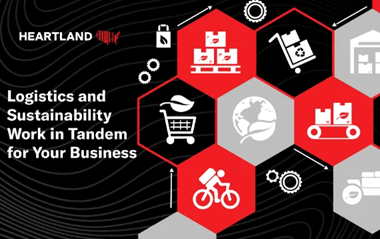
Reduce Your Carbon Footprint with a Circular Supply Chain
Dec 11, 2023
Sustainability is expected to be one of the top drivers for modernization in the coming year. Supply chains are quickly learning that modern consumers and businesses alike prioritize relationships aiming to reduce their carbon footprint. As a matter of fact, past research has found that six in ten consumers will seriously evaluate a brand’s commitment to sustainability before completing a purchase. Furthermore, eco-friendly practices have been shown to help supply chains save money as tasks are more streamlined and automated to minimize waste. Most importantly, sustainable practices ultimately help to reduce carbon emissions, benefiting the entire globe. As one of the primary sources of carbon emissions, supply chain workflows significantly impact the environment. Therefore, it is becoming increasingly critical for individual businesses to focus on sustainable practices. However, a brand’s dedication to sustainability requires close communication and effort from the entire supply chain, which explains the emerging popularity of circular supply chains.
What is a Circular Supply Chain?
A circular supply chain is a system that emphasizes the reuse, recycling, and repurposing of materials to diminish waste and promote sustainability. Leveraging visibility technologies and adaptable connectivity, circular models involve all stages of the supply chain process, from raw material extraction to the end of product life.
While circular supply chains may vary depending on business types, most circular models include the following components:
- Clear Reverse Logistics – When products or materials are returned, businesses require transparent visibility throughout the reverse logistics process to sort inventory and separate it from brand-new stock. Visibility tools such as RFID and barcoding are critical in the circular supply chain to capture the value of used products and materials. Advanced systems are also able to record proof-of-condition images straight to your management system. By collecting used products and materials, businesses may repurpose them, recycle them, or resell them, creating new revenue streams and reducing waste.
Related: Looking to optime your reverse logistics system? Here is what you’ll need.
- Customer Service – If teams are equipped with accurate, real-time data, they are able to provide better customer support for order tracking and product details. Mobility solutions with terminal operating software provide insight into an order’s progress through the supply chain to accurately estimate the time of delivery and return.
- Reliable Networks – Collaborative networks must sustain communication between manufacturers, suppliers, distributors, and logistics teams to create a closed-loop system. By partnering with a network design team, businesses can orchestrate connectivity architectures to include flexible options such as WiFi, 5G, and cellular within their data-sharing system. This allows teams to update one another on any changes and coordinate returns to reflect accurate stock counts.
Diving Into the 5 Benefits of Circular Supply Chains
Circular supply chains are quickly becoming a popular solution for businesses looking to reduce their carbon footprint and promote sustainability. While the benefits are numerous, here are five commonly expected advantages for modern supply chains.
- Protects the Environment - One of the primary benefits of circular supply chains is their ability to reduce the environmental impact of the supply chain process. Studies suggest supply chains are responsible for at least 80% of greenhouse gas emissions worldwide. Similarly, transportation companies release over 30% of volatile organic compounds, which can harm the human body after prolonged exposure. By eradicating e-waste and streamlining delivery routes and transportation, supply chains can begin to minimize pollution and adhere to their sustainability goals.
Related: Check out our article on how sustainability empowers transportation and logistics teams.
- Increases Cost Savings – Order fulfillment can account for half of your total warehouse expenses when factoring in storage costs, labor, and technology support. Warehouses depending on manual data management can reduce paper waste while increasing accuracy rates with adaptable automation. In place of pen-and-paper reporting, terminal operating software connects data to a centralized database to properly share and store data.
- Supplier Transparency – 45% of American companies are now asking suppliers to report environmental data. As a result, experts recommend re-evaluating materials and considering eco-friendly substitutions. While this may not always be possible, efficient traceability systems and checkpoints at the receiving dock assist in verifying materials and ensuring they meet your sustainability standards as well as government compliance.
- Positive Brand Image – Nowadays, consumers look for more than product availability and price. By adopting circular supply chain practices, businesses create a positive brand image and gain a competitive advantage, especially as products become more diversified across brands. Consequently, businesses can offer unique products alongside services that support customer values. Moreover, in promoting their commitment to sustainability, businesses may also attract customers who are willing to pay a premium for eco-friendly products and services.
- Increased Adaptability During Disruptions – Finally, circular supply chains enable more resiliency by reducing dependency on a single supplier. As a result, teams have a better chance of maintaining business continuity during shortages and disruptions, such as unexpected market changes and economic downturns. Real-time visibility and communication with suppliers can also assist with better forecasting to reduce overstocking and lower storage costs.
Basic Tips to Get Your Circular Solution Started
Before seeking to implement a circular model, consider meeting with a solution strategist to see if your workflows are ready to accommodate change. Initial adjustments can help prepare your operations to track returned materials without delaying workflows. The following tips can be helpful in preparing your facility for a circular solution:
- Assess your connectivity to target blind spots and dead zones. Effective supply chain management hinges on unbroken visibility. Therefore, consider evaluating your connectivity points to uncover problem areas and remediate dropped signals. Moreover, a network evaluation can also highlight consolidation opportunities where several tracking tasks, such as scanning and data sharing, can be streamlined in one ergonomic terminal, thus preventing your network from running too many devices simultaneously.
- Evaluate suppliers preemptively to ensure products meet your sustainability goals. Sustainable material sourcing will empower businesses to accurately estimate their environmental impact while also assessing ethical backgrounds and the longevity of your business relationship. Once again, digitized reporting comes in handy for this as it allows businesses to track and compare suppliers without relying on error-prone manual systems.
- Communicate with stakeholders and customers. Engage and educate your customers and partners about new changes to minimize disruptions and encourage participation. This approach not only promotes sustainability but also fosters a positive brand image.
Circular supply chains are just one of the many ways businesses are adapting to overcome challenges and minimize their carbon footprint. From mass digitization to hardware consolidation, modern technology solutions must address sustainability concerns to thrive in today’s markets. Meet with our automation team to learn more tips and methods designed to empower sustainable supply chains.




